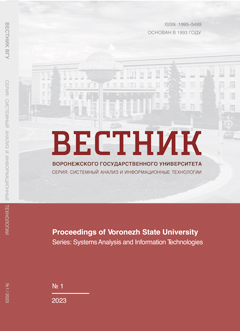Разработка двухэтапного метода нечеткой кластеризации событий информационной безопасности в системе мониторинга кибербезопасности субъектов экономической деятельности
Аннотация
Работа направлена на повышение эффективности управления кибербезопасностью субъектов экономической деятельности (СЭД) за счет организации эффективного мониторинга кибербезопасности (КБ), учитывающего такие особенности его процесса, как неоднородность источников исходных данных мониторинга КБ, их представление в разных форматах данных, их неточность, во многом неопределённость и зашумлённость, а также большое количество событий информационной безопасности (ИБ), обрабатываемых неоднородными компонентами системы мониторинга КБ СЭД. В работе предлагается комплексный двухэтапный метод нечеткой кластеризации событий ИБ, учитывающий оценки критичности событий ИБ и функциональные возможности системы мониторинга КБ СЭД. На первом этапе используется модель кластеризации событий ИБ в системе мониторинга КБ СЭД на основе метода нечетких c-средних. Эта модель позволяет кластеризовать множество событий ИБ на 3 нечётких кластера: нечёткий кластер событий ИБ, являющихся инцидентами ИБ, нечёткий кластер событий ИБ, не являющихся инцидентами ИБ и нечёткий кластер событий ИБ, требующих дополнительного анализа. На втором этапе для уточнения результатов кластеризации событий ИБ, полученных на первом этапе, используется модель кластеризации событий ИБ в системе мониторинга КБ СЭД на основе метода выделения α-ядер нечетких кластеров. Эта модель позволяет выбирать вручную пороги степеней принадлежности событий ИБ нечётким кластерам с учетом дополнительной информации и особенностей обработки событий ИБ в системе мониторинга КБ конкретного СЭД. В работе приводится оценка работоспособности разработанного двухэтапного метода нечеткой кластеризации событий ИБ в системе мониторинга КБ СЭД на конкретном примере. Предложенный подход позволяет повысить эффективность мониторинга КБ СЭД и сократить период времени, необходимый для принятия решения на управление ИБ СЭД за счет комплексного учёта особенностей обработки событий ИБ в системе мониторинга КБ конкретного СЭД.
Скачивания
Литература
2. Onyango Oscar. Artificial Intelligence and its Application to Information Security Management. DOI
3. Sizov V. A. and Kirov A. D. (2020) Problems of implementing SIEM systems in the practice of managing information security of Economic Entities. Open Education. 24(1). P. 69–79. (In Russian) DOI
4. Vulfin A. M. (2022) Detection of network attacks in a heterogeneous industrial network based on machine learning. Programmnaya Ingeneria. 13(2). P. 68–80. (In Russian) DOI
5. Kotenko Igor and Igor Parashchuk (2020). Model of security information and event management system. Vestnik of Astrakhan State Technical University. Series: Management, computer science and informatics. P. 84–94. DOI
6. Eryshov V. G. and Ilina D. V. (2020) Method of the information security monitoring process in information and telecommunication systems based on the application of methods of Markov Random Processes. 2020 Wave Electronics and its Application in Information and Telecommunication Systems (WECONF) [Preprint]. (In Russian) DOI
7. Korolev V. I. (2020) Protsessnaia model’ monitoringa i reagirovaniia na intsidenty informatsionnoi bezopasnosti. Informatsionnaia bezopasnost’: vchera, segodnia, zavtra : Sbornik statei po materialam III Mezhdunarodnoi nauchno-prakticheskoi konferentsii, Moskva, 23 aprelia 2020 goda [Information Security: Yesterday, Today, Tomorrow: Collection of articles based on the materials of the III International Scientific and Practical Conference, Moscow, April 23, 2020]. Moskva: Rossiiskii gosudarstvennyi gumanitarnyi universitet. P. 18–25. (In Russian) – EDN APZTCW.
8. Kirov A. and Sizov V. (2022) Development of a method for targeted monitoring and processing of information security incidents of economic entities. J Comput Virol Hack Tech. P. 1–6. DOI
9. Kaffah F. M., Irfan M., Slamet C., Berhat C., Rahman A. B. A. (2021) Implementation of the fuzzy logic for measuring instrument evaluation results in Information Security Index. IOP Conference Series Materials Science and Engineering. 1098.062003. P. 1–8. DOI
10. Lee Ming-Chang (2014) Information Security Risk Analysis Methods and Research Trends: AHP and Fuzzy Comprehensive Method. International Journal of Computer Science and Information Technology. № 6. P. 29–45.
11. Sidorova D. N., Pivkin E. N. (2022) Algoritmy i metody klasterizatsii dannykh v analize zhurnalov sobytii informatsionnoi bezopasnosti [Algorithms and methods of data clustering in the analysis of information security event logs]. Bezopasnost’ tsifrovykh tekhnologii = Digital Technology Security. No 1 (104). P. 41–60. (In Russian) DOI
12. Viattchenin D. A. (2009) Methodology of Data Analysis Based on Multistage Fuzzy Clustering. United Institute of Informatics Problems of the National Academy of Sciences of Belarus. Artificial intelligence. (In Russian)
13. Al’-Rammakhi Ali Abidalkarim Khabib Kh., Sari Farakh Abbas A. and Minin Iu. V. (2019) Modifikatsiia metoda nechetkoi klasterizatsiia s-srednikh s ispol’zovaniem metoda roia chastits dlia obrabotki bol’shikh dannykh. Sovremennaia nauka: teoriia, metodologiia, praktika : Materialy 1-i Vserossiiskoi (natsional’noi) nauchno-prakticheskoi konferentsii, Tambov, 26–27 noiabria 2019 goda [Modern science: theory, methodology, practice: Proceedings of the 1st All-Russian (national) scientific and practical conference, Tambov, November 26–27, 2019.]. Tambov : Izdatel’stvo Pershina R.V., P. 231–233. (In Russian) – EDN RTAOOJ.
14. Tran Khang, Vuong Nguyen, Tran ManhKien and Fowler Michael (2020) Fuzzy C-Means Clustering Algorithm with Multiple Fuzzification Coefficients. Algorithms. V. 13. P. 158. DOI
15. Viattchenin D. A. (2004) Fuzzy automatic classification methods. Minsk : Techno print. 219 p.
16. Sizov V. A. and Kirov A. D. (2021) The development of models of an analytical data processing system for monitoring information security of an informatization object using cloud infrastructure. Russian Technological Journal. 9(6). P. 16–25. (In Russian) DOI
17. James C. Bezdek, Ehrlich Robert and Full William. FCM: The fuzzy c-means clustering algorithm. Computers & Geosciences. No 10. P. 191–203.
- Авторы сохраняют за собой авторские права и предоставляют журналу право первой публикации работы, которая по истечении 6 месяцев после публикации автоматически лицензируется на условиях Creative Commons Attribution License , которая позволяет другим распространять данную работу с обязательным сохранением ссылок на авторов оригинальной работы и оригинальную публикацию в этом журнале.
- Авторы имеют право размещать их работу в сети Интернет (например в институтском хранилище или персональном сайте) до и во время процесса рассмотрения ее данным журналом, так как это может привести к продуктивному обсуждению и большему количеству ссылок на данную работу (См. The Effect of Open Access).



















